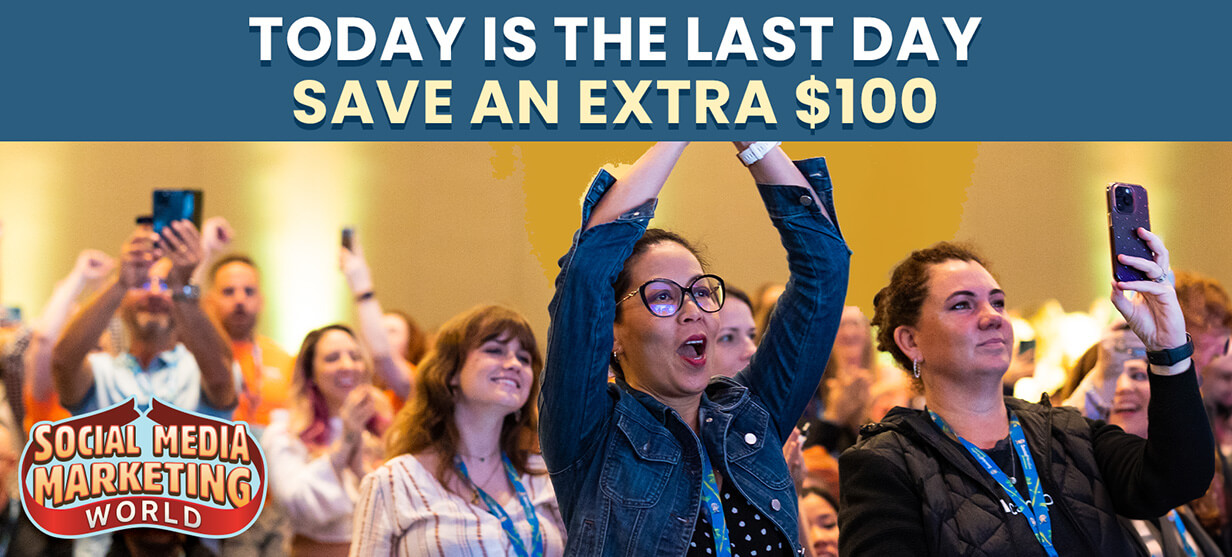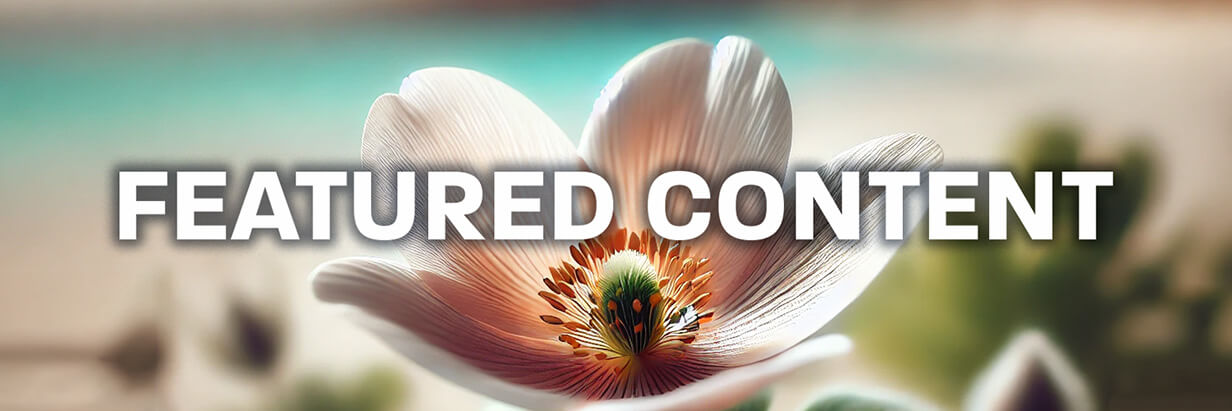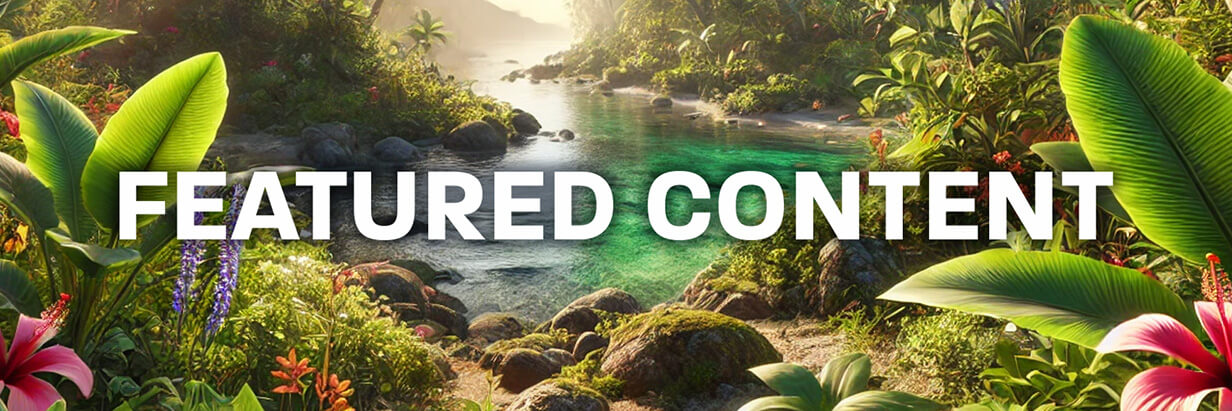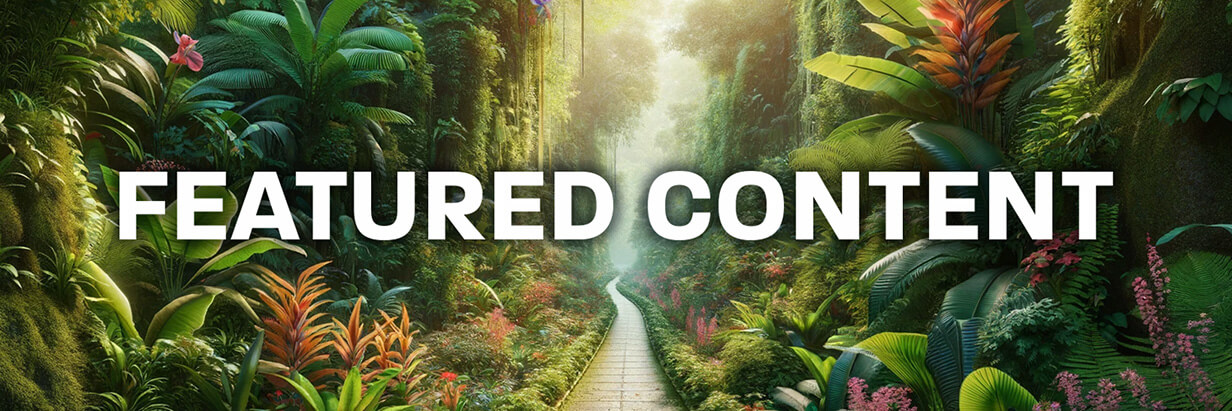Today's Guide to the Marketing Jungle from Social Media Examiner... | Presented by |  |
It's National Mason Jar Day, Alluser... Made for canning but great for leftovers!
In today's edition:
-
🤳 Today's Tip of the Day is for Instagram
-
🧲 🤝 Forging relationships that grow your busines
-
☺️ Communication tips for working with AI
-
🪝 Stopping the scroll for video ads
-
LinkedIn consolidates Live features
-
YouTube Shorts tools
-
TikTok Studio launches
-
🗞️ Additional industry news from LinkedIn, Threads, YouTube and more

Do your Instagram Reels need to deliver more results? Could your content mix use some grounding?
3 Types of Strategic Instagram Reels to Rotate
Drive Sales With Sell Shots: When creating a sell shot, be clear about what you're selling and why people should buy it—be clear about the value you're offering and include a strong call to action. Instead of just showing your product on a plain background, include multiple elements that might catch people's attention.
For example, if you're selling a coffee mug, you would show it being used in a beautiful location, like a park or beach.
Sell shots are a great place to use transitions. For instance, you could show the mug being placed on a table, and it changes color when it touches the surface. This shot creates a visually interesting moment that captures attention while still showcasing your product.
Get More Shares, Saves, and Comments With Engagement Shots: Unlike sell shots, engagement shots aren't about selling directly. Instead, they focus on educating or entertaining your audience.
For example, an engagement shot might be a video teaching proper form for a specific exercise if you run a gym. If you sell coffee mugs, you might share a "life hack" about using the mug to organize office supplies. The idea is to create content people want to save for later or share with friends.
Trends can be a great source of engagement content. By putting your spin on a popular trend, you can tap into your existing audience's interest.
Connect With Your Audience With Culture Shots: When people understand and respect your story, they're more likely to support you when you ask for a sale. This shot might involve telling your company's story, sharing behind-the-scenes content, or highlighting your company culture.
For example, if you're a founder of a coffee mug business, you might create a Reel that says, "Hi everybody. Today, I want to mix it up a little bit. I want to tell you how my family got into the coffee mug business. My grandfather was among the first people in Canada to bring coffee mugs from Europe."
Today's tip was inspired by Eden Hazan, a featured guest on the Social Media Marketing Podcast.

Last Chance for Your Special Subscriber Discount
Want to kickstart 2025 with fresh strategies that get results? Grab your All-Access ticket and join thousands of fellow marketers for three days of hands-on learning and authentic connections at Social Media Marketing World.
"Unless you've been here, you can't know how incredibly life-changing it can be," shares Sarah Brodie.
But hurry. Your final opportunity to save an extra $100 off your All-Access ticket expires at midnight!
I'm ready to claim my extra discount: AlluserSave$100

Two Ways to Open Strategic Partnerships That Scale With Less Effort
Are your marketing efforts falling flat? Wondering how to build meaningful business relationships to help your business grow?
Seek Out Strategic Relationships
Slim introduces the idea of tiny marketing actions—small, consistent steps that build relationships over time. This approach is grounded in the science of habits, drawing inspiration from works like James Clear's Atomic Habits and BJ Fogg's Tiny Habits.
The principle is simple but profound: making a one-percent improvement each day in your partnership-building efforts can lead to exponential growth over just a year.
Start with small, strategic touches:
After you've built up a genuine rapport, you can strategically place yourself in venues to meet them in person.
It won't happen overnight, but if you are invested and engage in genuine human interaction over time, you'll likely get your chance–either through your own efforts or through an introduction from someone you both know.
One particular year at South X Southwest, Pamela attended the event specifically to connect with brand partners.
Rather than spreading herself thin across multiple venues for a chance encounter, she strategically positioned herself in the bloggers' lounge, where she ultimately met representatives from Citrix through an introduction from someone in her network.
This connection led to a significant partnership that transformed her business.
Evaluating Potential Partners
As much as Pamela advocates for partnerships, she is the first to tell you, "Tread lightly."
You have built a reputation as a professional. When you share a referral with someone else, you put your reputation on the line.
Take things slowly and evaluate every partnership before committing to ensure you and your potential partner have a shared values perspective. Ask questions such as:
-
Why are you in business?
-
Do you have thought leadership?
-
Are you creating something worth selling, and is it meaningful to the world?
-
What are your values?
-
What are your anchors for morals and ethics?
If the partnership isn't a perfect fit, it's better to walk away than endanger your client and reputation.
Attract the Right Partners: Build Your Beacon
While actively seeking partnerships is essential, Slim emphasizes the equal importance of creating a beacon–the platforms and quality content that attract potential partners to you.
Your beacon might take many forms–a podcast, newsletter, blog, or social media presence, but its essential purpose remains the same: to demonstrate your expertise and value to potential partners.
When potential partners research you–as they inevitably will, they should find a straightforward, compelling story that helps them understand how a partnership might benefit their goals and audience.
Tips for Scaling Partnership Relationships
The journey from initial partnership to scaled success requires careful attention to human relationships and systematic approaches.
Slim shared an enlightening example through her experience with a speaker agency she encountered in San Diego.
This agency had developed a unique approach to partnership scaling that went beyond traditional speaker representation. Instead of simply booking speaking engagements, they conducted detailed research into potential speaking opportunities, managed relationship building, and created scalable systems for their clients' success.
The brilliance of this approach lies in its ability to maintain personal connection while leveraging systems for growth.
The agency didn't just connect speakers with opportunities; they developed a deep understanding of each association, conference, and venue they worked with. They know the decision-makers and audiences and can match speakers with opportunities that truly serve everyone involved.
This systematic approach to what might otherwise be an overwhelming networking task demonstrates how partnerships can be scaled without losing their essential human element.
Technology can also support partnership building without replacing the essential human element.
Tools like email automation, CRM systems, and project management platforms can help manage partnerships at scale while emphasizing the importance of maintaining personal connection and authentic relationship building.
The key to successful systemization lies in understanding which elements of partnership building can be standardized and which require personal attention. For instance, initial research and outreach processes can often be systematized, while relationship development and strategic discussions typically require direct personal involvement.
Today's advice is provided with insights from Pamela Slim, a featured guest on the Social Media Marketing Podcast.

Mastering AI Communication: The Foundation of Success
The most crucial skill in AI mastery is learning how to communicate effectively with these tools.
This skill goes far beyond simple prompt engineering - it's about developing a comprehensive communication strategy that consistently delivers results.
Here are three expert tips to try today.
The Power of Role Definition in AI Projects
Every interaction with AI should begin with a clear definition of its role.
The role isn't just a formality - it fundamentally shapes how the AI approaches your request.
"You should always be starting your conversation with telling the AI who it is in the context of this conversation," Leffer emphasizes.
The specific language you use matters more than you might think.
Through extensive A/B testing with multiple AI tools, Leffer has discovered that saying "You are" produces consistently better results than "Act as." The psychology behind this is fascinating. When you tell the AI to act as something, you're essentially asking it to pretend or mimic. But when you tell it that it is something, you establish a deeper framework for the interaction.
Consider these two approaches:
Wrong: Act like a social media expert and help me write a LinkedIn post about artificial intelligence in healthcare.
Right: You are the world's leading social media strategist with specialized expertise in LinkedIn B2B copywriting and deep knowledge of the healthcare technology sector. You have a proven track record of creating engaging content that strictly complies with healthcare regulations while driving meaningful engagement.
The difference might seem subtle, but the impact on output quality is significant. The second approach provides rich context that guides the AI's understanding and shapes its response.
The Surprising Impact of Politeness in AI Prompts
One of the most counterintuitive discoveries in AI communication is the importance of politeness.
"There has been some really bad viral advice not to say please to the AI," Leffer reveals. That's awful advice. There are actually studies that have come out that it improves the quality of the response."
Being polite isn't just about adding pleasantries - it's about treating the AI as you would a knowledgeable colleague. The more human psychology you apply in your interactions with AI, the better your results will be. Examples include:
-
Expressing appreciation for the AI's efforts
-
Acknowledging the importance of the task
-
Providing context about real-world impact
-
Using please and thank you consistently
-
Giving the AI time to think"through complex problems
The Art of Context Setting
Beyond politeness and role definition, providing rich context is essential for getting optimal results from AI tools. This isn't just about stating your immediate needs - it's about painting a complete picture that helps the AI understand the broader situation and objectives.
"You need to understand that things work in some contexts and not others," Leffer explains. "It depends what you're doing."
She's discovered that different psychological approaches work better for different types of tasks. For instance, telling the AI it's well-caffeinated can improve performance on analytical tasks but might hinder creativity.
When setting context, consider including:
Background Information: Our company is a B2B healthcare technology provider that helps hospitals streamline their patient intake processes. We're preparing content for a major product launch targeting hospital administrators and IT directors.
Specific Constraints: All content must comply with HIPAA regulations and maintain a professional, authoritative tone while still being accessible to non-technical decision-makers.
Clear Objectives: The goal is to generate interest in our new platform by highlighting its ROI potential and ease of implementation, ultimately driving demo requests from qualified prospects.
Today's advice provided with insights Nicole Leffer, a featured guest on the AI Explored podcast.

How to Create Persuasive Video Ads That Convert: Pattern Interrupts, Audience Callouts, and Hooks
Want to stop the scroll and engage your audience with video ads? Curious about the key elements that make a video ad irresistible?
While organic content remains valuable for long-term growth, paid video ads offer unique advantages you shouldn't overlook.
You can reach the exact audience you want to get in front of, and validate offers in days rather then weeks. Finally, once you find a winning video ad, you can scale your success by increasing ad spend.
With over two decades of video experience, including working directly with renowned marketer Russell Brunson, Anson has identified seven key psychological ingredients that make video ads convert.
Today, we're covering pattern interrupts, audience identification, and hooks.
Pro Tip: If you're worried that creating effective video ads will require expensive equipment or professional editing skills, you can set the worry aside. Today's smartphone cameras and simple editing apps allow anyone to create high-converting video ads.
#1: Pattern Interrupts That Stop the Scroll
In today's social media environment, you compete against an endless stream of content for your viewer's attention. The first crucial seconds of your video ad are make-or-break territory. This is where the psychology of pattern interrupts becomes essential.
Here are four types of effective pattern interrupt techniques, with examples, to try:
Visual Disruptions: Wave enthusiastically at the camera before speaking, use dramatic hand gestures or movements, and implement quick zooms or camera movements.
Create Unexpected Transitions: Use bold colors or striking visuals, add technical effects, implement glitch effects, or use VHS tape visual artifacts.
Add Static or Interference Effects: Create screen distortions, incorporate quick cuts or transitions and dramatic entrances, or match-cut from viral clips into your entrance.
Use Creative Transitions From Popular Content: Create unexpected scene changes, implement surprise reveals, use motion to draw attention, or introduce attention-grabbing props.
#2: Audience Identification
Even if you've carefully targeted your ad settings, stating who you're speaking to explicitly is crucial for engagement and conversion.
At the start of your video, clearly identify your target audience to activate a psychological trigger in your viewers: recognition response.
When viewers immediately know if the message is for them, they quickly self-qualify or disqualify, helping you create an instant connection with qualified prospects.
As more viewers self-qualify, the algorithm's AI systems better understand your target audience, which improves ad delivery to more relevant viewers, reducing wasted ad spend on unqualified viewers and enhancing overall campaign performance.
Here are three types of audience identification techniques, with examples, to try.
Direct Role Identification
Situation-Based Identification
Problem-Based Identification
#3: Hooks That Demand Attention
Next, you need a powerful hook to sustain your viewer's attention.
Here are seven types of hooks, with examples, that consistently drive engagement and prevent viewers from scrolling past your ad.
The Fact or Statistic Hook: Present surprising industry data, share unexpected research findings, reveal compelling market trends, or use numbers that challenge assumptions. For example: "Did you know that 87% of successful businesses already use this overlooked marketing strategy?"
The Objection Hook: Address common resistance points, challenge prevalent misconceptions, tackle industry myths head-on, or confront typical skepticism. For example: "Think Facebook ads don't work anymore for coaching businesses? Using this method, our clients just generated 127 qualified leads in the past 30 days."
The Pain or Desire Hook: Highlight urgent problems, address pressing challenges, emphasize aspirational goals, or touch on emotional triggers. For example: "Tired of working 60-hour weeks while watching your competitors scale effortlessly?"
The Polarization Hook: Challenge conventional wisdom, present controversial perspectives, question established practices, or offer alternative viewpoints. For example: "Websites are dead. Funnels are the new way to generate leads, and here's why..."
The Rhetorical Question Hook: Pose thought-provoking questions, challenge existing beliefs, stimulate self-reflection, or create cognitive engagement. For example: "What if everything you've been told about customer acquisition is wrong?"
The Strong Statement Hook: Make bold declarations, present powerful assertions, offer definitive perspectives, or state compelling truths. For example: "AI is about to make 90% of traditional marketing strategies obsolete."
For maximum impact, test hook combinations with small ad budgets to identify which resonates most strongly with your specific audience. For example, you can combine Audience ID with a strong statement hook and fact Hook: "To all e-commerce owners: Your website might be losing 67% of potential sales because of this overlooked mistake."
Check with us on Monday to learn three elements that establish credibility and drive action!
Today's advice is provided with insights from Kevin Anson, a featured guest on the Social Media Marketing Podcast.

LinkedIn Live Event Features: LinkedIn is consolidating its live event features by merging Audio Events and LinkedIn Live into a single system. Native Audio Events will no longer be available for creation after December 2, 2024. Existing Audio Events can run as scheduled until December 31, 2024. Events scheduled beyond December 31 must be recreated through LinkedIn Live by December 15, 2024, or they will be removed. Under LinkedIn Live, audio-only events must now use third-party streaming partners instead of LinkedIn's native hosting. Event interaction will occur through comments, with speakers needing access to the chosen streaming platform to participate live. All LinkedIn Live events are automatically recorded and can be shared afterward. Source: LinkedIn
Threads Content Ranking: The platform is implementing two key updates. Content from followed accounts will be prioritized in users' feeds, resulting in fewer recommendations from unfollowed accounts. For creators, this means their content will reach more of their existing followers (increased "connected reach") but fewer non-followers (decreased "unconnected reach"). Source: @mosseri via Threads
X for iOS: The platform announced that iOS app users can now hide engagement buttons and numbers for likes, reposts, and replies and interact with posts through custom swipe gestures instead. Rather than tapping the buttons to like or reply, you can now swipe left or right on a post to perform different actions. You can customize these gestures in your settings to choose what each swipe does. Source: @mayxlyy via X
Connect Claude to Data Sources: Anthropic has released the Model Context Protocol (MCP). This open-source standard allows AI assistants to connect directly with various data sources and business tools. MCP provides a universal protocol for AI-data connections, replacing the need for multiple custom integrations, and includes SDKs, local server support in Claude Desktop apps, and an open-source repository of pre-built servers for popular platforms like Google Drive, Slack, and GitHub. Developers can use MCP immediately through the Claude Desktop app, with expanded deployment options for Claude for Work customers coming soon. Source: Anthropic
Zoom Rebrand: Zoom is repositioning itself as an AI-focused technology company that extends beyond its well-known video conferencing platform. The company now emphasizes its role in providing comprehensive solutions for hybrid work environments, with AI technology at the core of its business strategy to facilitate smooth collaboration. Source: Zoom
Instagram DM Features: The platform is adding 17 new sticker packs containing over 300 stickers and the ability to favorite and reuse stickers from chats, including those created with cutouts. Users can now create custom nicknames for themselves and their friends within DM conversations. These nicknames only appear in direct messages and don't affect usernames elsewhere on Instagram. Users maintain control over who can change their nicknames, with the default setting allowing changes from followed accounts. A new location-sharing feature will enable users to share their live location for up to one hour or pin specific locations on a map. This feature is designed to coordinate meetups and is only available in select countries. The location sharing is restricted to private DM conversations, cannot be forwarded to other chats, and includes safety features like automatic one-hour expiration and visible sharing indicators. Source: Instagram
Threads UX Experiments: Threads is testing new enhancements to its search functionality that will allow users to filter posts by specific date ranges and search within individual user accounts. For users in the United States, Threads is expanding its Trending Now feature to include more trending topics. Additionally, the platform is implementing AI technology to provide automated summaries of trending discussions. Source: @Mosseri via Threads In addition, the platform is also testing the option to let you choose the For You, following, or a custom feed as your default. Source: @Zuck via Threads
Video on Threads: Threads confirmed it now supports landscape video. Source: @Threads via Threads
TikTok Studio: TikTok launched the desktop platform to replace Creator Center Beta. This hub centralizes various creator tools, including analytics, creative resources, monetization options, and educational materials. Desktop users can access 'Unlimited Sounds' to protect their one-minute videos from being muted, with no restrictions on how long the feature can be used. Source: Lindsey Gamble via Threads
YouTube Shorts and Feature Updates: YouTube has completed rolling out updates allowing Shorts videos between 1 to 3 minutes to appear across the subscriptions tab, Channel pages, and YouTube Studio. These videos will now appear on the Shorts shelf on the subscriptions page and in the Shorts tab on channel pages and YouTube Studio. Creators who prefer their uploads to be considered long-form content can upload videos in a wider aspect ratio, like 16:9, instead of the Shorts format. YouTube is also introducing new features for sharing and publishing videos from other apps on Android and iOS, giving creators direct access to Shorts creation tools. Creators can trim videos, add captions, adjust visibility settings, set location, and enhance their videos before publishing, just as they can when creating directly in the YouTube app. YouTube has launched an improvement to quiz posts that allows creators to add images to multiple-choice answers, initially available on Android devices but visible to viewers on all platforms where Community posts are available. A new text transform tool helps creators rephrase and customize their post text, along with Dream Screen, which enables image generation based on prompts. YouTube is expanding access to BrandConnect, a self-service platform connecting creators with brand deal opportunities, by adding a dedicated tab in Studio under the earn section for all eligible creators. A pilot program called Open Call is being tested through December, allowing advertisers to request custom ad content from creators, with opportunities including creative prompts, brand information, and payment for selected content. YouTube is introducing a new "Captured with a Camera" disclosure in the expanded description box for content filmed using special technology that verifies videos through C2PA 2.1 or higher standards. The "Captured with a Camera" feature is separate from existing altered and synthetic labels and will be relevant to a small number of creators interested in validating their content's authenticity. Source: YouTube
Claude Style Selection: Anthropic introduced a new feature allowing users to customize Claude's communication style through the Claude interface. Using three preset style options, the styles feature enables users to tailor Claude's responses to match their specific communication preferences, including tone and structure. The Formal style delivers clear and polished responses. The Concise style provides shorter, more direct communication. The Explanatory style focuses on educational content that helps users learn new concepts. Source: Anthropic
Threads User Growth: A Meta spokesperson confirmed Threads gained 35M news users in November. Source: The Verge
LinkedIn Short-Form Video: LinkedIn has updated the engagement icons for short-form videos, replacing the Mute icon with a Save ribbon icon. Source: Social Media Examiner Editorial Team
YouTube Inspiration Tool: YouTube Studio announced new Inspiration tab enhancements designed to help creators generate content ideas. Accessible via the content page, this tool offers personalized suggestions with thumbnails, titles, and projected audience interest metrics. Creators can further explore these ideas in an Idea Playground, customizing them and experimenting with different angles. The tool also provides downloadable thumbnail images and the ability to save ideas for future use. This new tab replaces the former trends tab, which now focuses on non-AI features like top searches. YouTube utilizes generative AI to power these features, offering contextualized suggestions based on the creator's channel. Source: YouTube
What Did You Think of Today's Newsletter?
Did You Know?
The Mason jar got its name from John Landis Mason. He was the tinsmith who designed the jar's innovative lid, not the jar itself.

Michael Stelzner, Founder and CEO
P.S. Add
michael@socialmediaexaminer.com into your contacts list. Use Gmail?
Go here to add us as a contact.
We publish updates with links for our new posts and content from partners. Your information: Email:
tukangpostoemel@gmail.com Opted in on: 2021-09-06 17:20:47 UTC.









